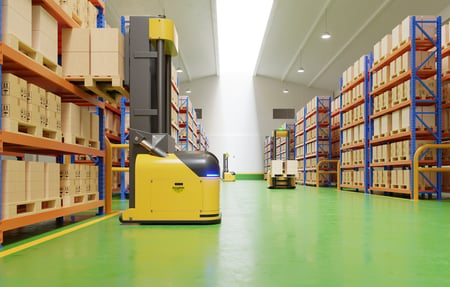
Manufacturers and warehouses are increasingly investing in automation technology to improve efficiency, reduce operational costs, and stay competitive in a rapidly evolving marketplace.
Automation enables businesses to streamline repetitive tasks, enhance precision, and reduce the likelihood of human error, leading to higher productivity and faster turnaround times. With the rise of e-commerce and the need for more responsive supply chains, automation helps companies manage growing demands while minimizing labor shortages and reducing manual workloads. Automating also makes environments more enjoyable for your talent and gives new opportunities for upskilling. Furthermore, automation technology provides real-time data insights, empowering manufacturers and warehouses to optimize inventory management, improve quality control, and make informed decisions that drive long-term growth and profitability.
Benefits of adopting the technology are clear, and a growing number of manufacturers and distributors are integrating robotic lift trucks into their facilities. But with every major process change, what are the downsides? Planning is crucial when investing in automation technology. Decide if the move is right for your company by asking yourself these questions.
-
Which technology is right for you? AMRs or Autonomous Mobile Robots are sophisticated robots that use sensors and advanced programming to perform complex tasks within an environment. Some AMR providers retrofit your existing forklifts allowing you to automate them and spend on software or AI and less on new equipment. AGVs or Automated Guided Vehicles, on the other hand, are robots that perform more basic functions along fixed routes. (For an in-depth explanation, check out this blog about AGVs.) Each technology has its pros and cons, but the best fit will depend on your industry, type of shipping, volume, and handling requirements. For example, a grocery store that conducts a large volume of quick, ship-to-consumer transactions with fragile items will have different material handling needs than a home improvement store that primarily sells in bulk to contractors.)
-
What’s your payback period? A good rule of thumb is to select AMR projects that payback after two years. Costs can be recouped quickly in high-velocity, multi-shift facilities, but will likely take an impractical amount of time for one-shift facilities. (But more on alternate routes in the next bullet point!) When calculating your ROI on automation tech, don’t forget to consider the costs you’ll save on employee turnover, training, sick days, and accidents--not just employee total cost. The best thing to do is start with a data assessment to understand your facility’s actual needs, then crunch the numbers from there.
-
Are robots as a service (RaaS) a good option for your company? We know—this sounds very Jetsons, but it’s a real thing—and it can save you time and money, especially if your company is a small- to medium-sized business. It works much like software as a service (SaaS) or other subscription services. RaaS allows you to either pay a monthly fee with a cancel clause or lease—rather than buy—robotic devices and gives access to a cloud-based subscription service. It’s appealing because it’s easily scalable—another issue highlighted by the pandemic—and offers predictable costs.
-
Who is responsible for the success (or failure) of your automation? While vendors should act as your partners, someone on your team must be the point person--responsible for the business process/capability you are deploying and the end results. Ideally, this is their main job function when implementing a new AMR/AGV technology and it is tied directly to their review. Your organization and people must own these implementations and the change management required--don’t necessarily expect your vendor partner to do that for you.
-
Will it play nice with existing systems? Mixing new automated technology with older systems can be tricky. Failure to integrate can lead to more trouble than your investment is worth. That's why any new piece of tech should be considered part of an overall material handling system design. This way, you can see and understand how everything will work together and address potential interoperability challenges beforehand. Reluctant to take the plunge? You can always start with a small trial and expand from there, adapting your learnings (and there will be learnings!) as you go.
Don't forget the power
If you do make the decision to start automating your forklifts with an AMR partner, don’t forget to consider the new needs you’ll have on the forklift power side. To make your AMR investment count, leverage a power management partner upfront to help you map the application changes you will make from your current manual processes to automated processes. (Will you run longer shifts or more shifts, for example?) It pays to design a holistic, data-driven material handling system that ensures your machines are operating with the optimal schedules and power usage parameters--and adding this step just isn’t that hard if you work with the right partner. Working with a power supply specialist will help you craft a strategy that saves you money and headaches over the long term.


 Ryan Lynch
Ryan Lynch
